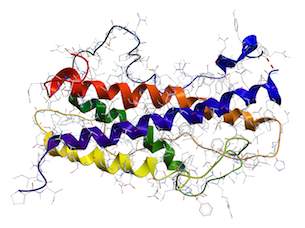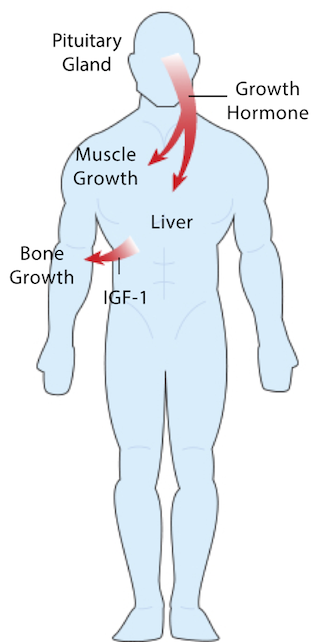Human growth hormone (HGH) is a hormone secreted by the pituitary gland (a small endocrine gland located at the base of the brain). It promotes muscle growth and bone growth.1 HGH can be more broadly described as an anabolic (muscle-building) hormone much like testosterone. It also helps to regulate body composition, body fluids, muscle and bone growth, and sugar and fat metabolism.
Effects of HGH include the following:
- Increased muscle growth (protein synthesis)
- Fat breakdown (lipolysis)
- Increased bone mineral density (bone growth)
- Immune system stimulation
- Blood glucose regulation
How Does HGH Work?
Growth hormone works by promoting the production of insulin-like growth factor (IGF-1) in the liver. IGF-1 is what actually produces the growth-stimulatory effects on a wide variety of tissues within the body. IGF-1 plays an important role in bone formation and muscle growth as well as in many other essential bodily functions.
When is HGH Released?
Growth hormone release occurs primarily during deep sleep. Increasing the quality and quantity of deep sleep increases the amount of growth hormone that your body releases. Its release is regulated by the hypothalamic peptides: GHRH and somatostatin. GNRH stimulates growth hormone release. Somatostatin inhibits its release.
The pituitary gland releases HGH in a pulsatile manner throughout the day and night. This pulsatile release causes HGH levels to increase and decrease periodically throughout the day. The highest levels are achieved approximately one hour after the onset of sleep. Nearly 70% of all HGH released into the body in a 24-hour period is released during deep sleep.2 As a result, quality sleep is essential for proper growth hormone release. Anything that interferes with sleep, such as alcohol, caffeine, sleep apnea, or certain medications, can severely reduce HGH release. The pulsatile manner of GH release makes it difficult to for physicians to diagnose HGH deficiency with a single blood test at any given time.
What is HGH: Human Growth Hormone and Aging
Effects of HGH are most pronounced during puberty, as levels are the highest during puberty. Yet, HGH plays a vital role in the body throughout life. Beginning in early to mid-adulthood, HGH secretion begins to decrease at an average rate of about 15% per decade.3 As a result, by late adulthood total secretion is typically far less than half of total secretion in early adulthood.4 The decline in HGH secretion that occurs with aging is often referred to as “somatopause”.
Both aging and GH decline are associated with decreased lean body mass, decreased bone density, and increased fat mass. They are also associated with increased abdominal fat, abnormal cholesterol levels, glucose intolerance, reduced aerobic endurance, and reduced immune function.4-5
Since aging is associated with declining growth hormone secretion, it has been hypothesized by some that some of these undesirable effects may, at least in part, be due to the decline in HGH production. Naturally, this thought has spurred considerable interest in administering supplemental human growth hormone as a “treatment” for aging in humans.
What is HGH: Chemical Makeup

Unlike testosterone, which is a single molecule, growth hormone is a peptide. Specifically, HGH is a long string of 191 molecules known as amino acids. This complexity makes the laboratory synthesis of growth hormone difficult. In fact, HGH was not synthesized in a laboratory until 1985. Prior to this date, growth hormone used to treat growth hormone deficiency was extracted from the pituitary glands of cadavers. Because the synthesis of exogenous growth hormone is difficult, it is expensive. HGH replacement therapy for growth hormone deficiency costs around $10,000 per year.
External Resources: Wikipedia: What is HGH?
Updated: May 12, 2015
1. http://en.wikipedia.org/wiki/Growth_hormone. What is HGH?
2. Van Cauter E, Plat L, Copinschi G. Interrelations between sleep and the somatotropic axis. Sleep. Sep 1998; 21 (6): 553-566.
3. Iranmanesh A, Lizarralde G, Veldhuis JD. Age and relative adiposity are specific negative determinants of the frequency and amplitude of growth hormone (GH) secretory bursts and the half-life of endogenous GH in healthy men. J Clin Endocrinol Metab. Nov 1991; 73 (5): 1081-1088.
4. O’Connor KO, Stevens TE, Blackman MR. GH and aging. In: Juul A, Jorgenson JOL, eds. Growth Hormone in Adults. Cambridge, UK: Cambridge University Press; 1996.
5. Corpas E, Harman SM, Blackman MR, Human growth hormone and human aging. Endocr Rev. 1993; 14: 20-39.





